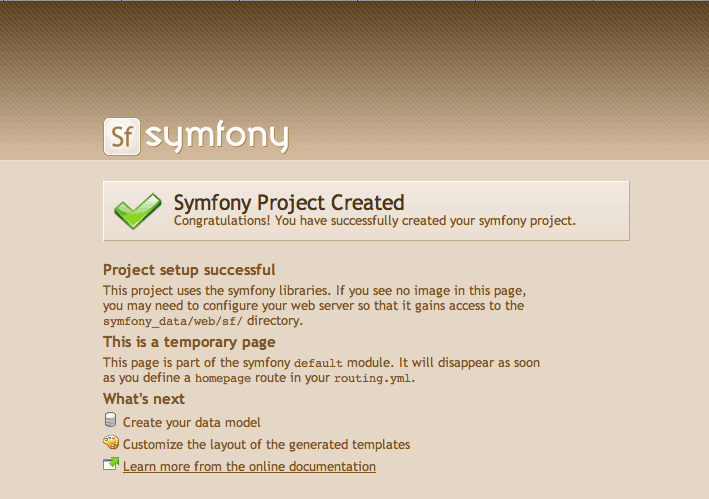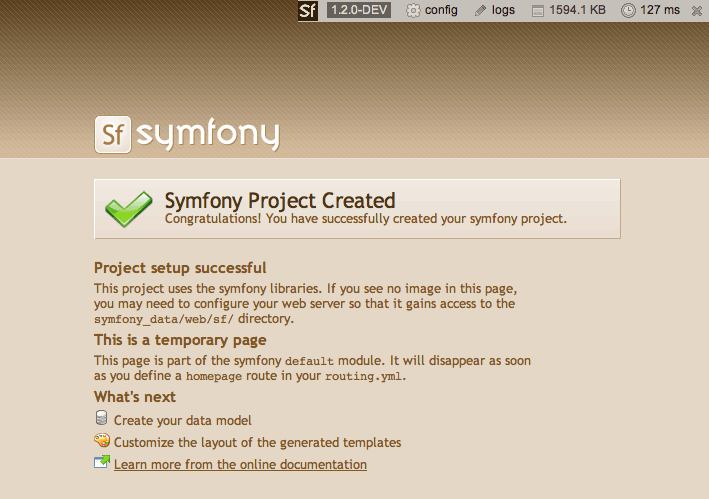The ugly Way
In the previous chapters, you have created a directory that hosts the project. If you have created it somewhere under the web root directory of your web server, you can already access the project in a web browser.
Of course, as there is no configuration, it is very fast to set up, but try to
access the config/databases.yml file in your browser to understand the bad
consequences of such a lazy attitude. If the user knows that your website is
developed with symfony, he will have access to a lot of sensitive files.
Never ever use this setup on a production server, and read the next section to learn how to configure your web server properly.
The secure Way
A good web practice is to put under the web root directory only the files that
need to be accessed by a web browser, like stylesheets, JavaScripts and
images. By default, we recommend to store these files under the web/
sub-directory of a symfony project.
If you have a look at this directory, you will find some sub-directories for
web assets (css/ and images/) and the two front controller files. The
front controllers are the only PHP files that need to be under the web root
directory. All other PHP files can be hidden from the browser, which is a good
idea as far as security is concerned.
Web Server Configuration
Now it is time to change your Apache configuration, to make the new project accessible to the world.
Locate and open the httpd.conf configuration file and add the following
configuration at the end:
# Be sure to only have this line once in your configuration
NameVirtualHost 127.0.0.1:8080
# This is the configuration for your project
Listen 127.0.0.1:8080
<VirtualHost 127.0.0.1:8080>
DocumentRoot "/home/sfproject/web"
DirectoryIndex index.php
<Directory "/home/sfproject/web">
AllowOverride All
Allow from All
</Directory>
Alias /sf /home/sfproject/lib/vendor/symfony/data/web/sf
<Directory "/home/sfproject/lib/vendor/symfony/data/web/sf">
AllowOverride All
Allow from All
</Directory>
</VirtualHost>
note
The /sf alias gives you access to images and javascript files needed
to properly display default symfony pages and the web debug toolbar.
On Windows, you need to replace the Alias line with something like:
Alias /sf "c:\dev\sfproject\lib\vendor\symfony\data\web\sf"
And /home/sfproject/web should be replaced with:
c:\dev\sfproject\web
This configuration makes Apache listen to port 8080 on your machine, so
the website will be accessible at the following URL:
http://localhost:8080/
You can change 8080 to any number, but favour numbers greater than 1024 as
they do not require administrator rights.
Test the New Configuration
Restart Apache, and check that you now have access to the new application by
opening a browser and typing http://localhost:8080/index.php/, or
http://sfproject.localhost/index.php/ depending on the Apache configuration
you chose in the previous section.

tip
If you have the Apache mod_rewrite module installed, you can remove
the index.php/ part of the URL. This is possible thanks to the
rewriting rules configured in the web/.htaccess file.
You should also try to access the application in the development environment (see the next section for more information about environments). Type in the following URL:
http://sfproject.localhost/frontend_dev.php/
The web debug toolbar should show in the top right corner, including small
icons proving that your sf/ alias configuration is correct.

note
The setup is a little different if you want to run symfony on an IIS server in a Windows environment. Find how to configure it in the related tutorial.
This work is licensed under the Creative Commons Attribution-Share Alike 3.0 Unported License license.